Furo Ashes, Kobukusa, and Buddist Kesa
Chanoyu can be presented throughout the year. During the cold winter half of the year, the kama, 釜, kettle, for heating water, the sunken hearth, ro, 炉, is used, and in the hot summer half of the year, the portable fu-ro, 風炉, wind-hearth, is used. However, the furo can be used at any time and almost anywhere.
Traditionally, the ro is opened on the first I-no-hi, 亥の日, Boar’s-day, in November, the 11th month. The 10th month, which is called Kan-na-zuki, 神無月, God-no-month, because the Shintō deities gather at Izumo Tai-sha, 出雲大社, Out-cloud Great-shrine. Therefore, the preparation for the last furo of the season may have the influence of Buddhism, as Buddhist deities remain in place. The furo is moved to the middle of the tatami like a Buddhist kō-ro, 香炉, incense-hearth.
The ash bed in the furo can be shaped and designed in different styles of hai-gata, 灰形, ash-form. In an open furo, the most familiar design of the ash bed is ni-mon-ji, 二文字, two-character-letter, with two horizontal, parallel ridges. This is done with or without the trivet-like go-toku, 五徳, five-virtues, that supports the kama over the sumi-bi, 炭火, charcoal-fire. For the 10th month, the ash bed can have lines drawn in the nimonji. Another form of furo is designed to support the kama, such as the kiri-kake bu-ro, 切掛け風炉, cut-hang wind-hearth, the ash bed is usually shaped into a circle that has a profile of a wide, shallow volcano. Radiating lines can be drawn on the surface of the ash bed.
The finest ash prepared for the furo is called fukusa-bai, 帛紗灰, cloth-gauze-ash. The fuku-sa, 帛紗, cloth-gauze, square of fine silk fabric used by the host to purify utensils. Most ash used in the furo and the ro is made of burned charcoal made of kunugi, 椚, a kind of oak tree. Fukusa bai is processed by sifting, mixing with water, and then gathering the ash that settles to the bottom of the bucket. This is dried before use. The name ‘fukusa’ comes from the texture of the ash that is like the finest silk. The fukusa may also come under the influence of the Buddhist kesa.
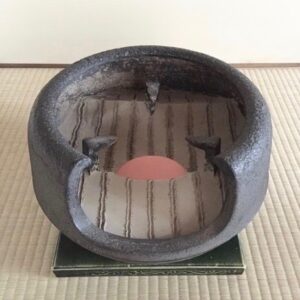
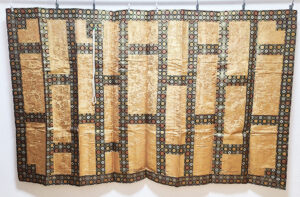
Pictured at top, the line pattern drawn in the ash of the tetsu bu-ro, 鉄風炉, iron wind-hearth, is called ni-mon-ji kaki-age bai, 二文字掻上げ灰, two-letter-character scratch-up ash. The lines, suji, 筋, are drawn with one of the hi-bashi, 火箸, fire-rods. The lines are drawn in accord with the gotoku and the mae-kawarake, 前土器, fore-earth-container, which is appropriately red for use in an iron furo. The raked lines may be drawn in most types of furo. In the above image the design has nine parallel lines drawn on the ash bed from front to back, creating eight spaces, that may have symbolic significance.
According the Asian zodiac, the 10th month is marked with the sign of the Inu, 戌, Dog. Together with the 11th month, I, 亥, Wild Boar, they are called Inu-I, which is written with Kanji, Ken, 乾. Both signs are protected by A-mi-da Nyo-rai, 阿弥陀如来, Praise-increase-steep Like-become. Note the ceramic tile supporting the furo, is Ori-be-yaki, 織部焼, Weave-guild-fired.
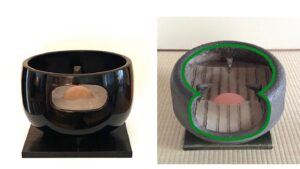
Rikyū’s mayu bu-ro, 眉風炉, eyebrow-window, is an open bowl with an ovoid opening at the front of the vessel; diam. 8 sun kane-jaku. The Dōan style furo is a bowl opening that joins continuously with the ‘himado’ opening. The Dōan buro is like the mayu buro, but without a ‘bridge’, that separates the two openings. This form creates an opening that has the profile of a bottle gourd, hyō-tan, 瓢箪, gourd-basket. The outline of the ‘gourd’ is inverted, the smaller chamber below the larger, which bears the name ‘tan–pyō’. The inverted gourd is a vessel that when used it is inverted to pour out its contents. Both words and forms are deeply symbolic, and it is a sacred symbol in Taoism. In Chinese symbolism of the Go-gyō, 五行, Five-transitions, five physical elements, the Jīn hú-lu, 金葫芦, ‘Gold (Metal) gourd’, provides protection from fire.
The outline of the bottle gourd is like the number 8, in Japanese hachi, 八, which is the number emblematic of Infinity in Space. The contents of the bottle gourd, kanro, can create the experience of Infinity in Time.
The lines in the mayu buro are drawn in the ash bed across the two ridges of the ni-mon-ji, に文字, two-character-letters. The width of each horizontal ridge is approximately 6 sun kane-jaku. The number six is symbolic also of Infinity in Time. Another familiar haigata for the furo is the tō-yama, 遠山, distant-mountain.
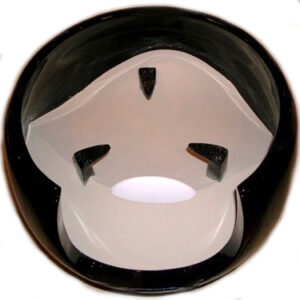
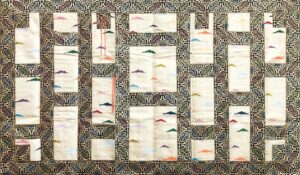
The kesa, is a rectangle of various sizes made of pieces of fabric patched together. Depending on the sect of Buddhism, the kesa is often worn draped over the left shoulder or with a strap worn like a bib. The Buddha decreed that the kesa should be made of rags and discarded cloths, that are cleaned. However, time brought changes in making the kesa with sumptuous fabrics to honor the Buddha. Depending on its size, the number of panels of the kesa are varied according to the sect. The standard number of panels include 5, 7, 9, 11, 15, 25, and more.
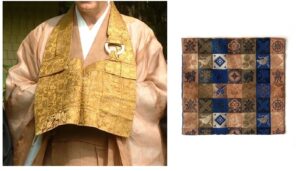
The raku-su, 絡子, join-of, is variation of the kesa, is worn by lay people, and by monks at work, and is rather more like a rectangular apron with two straps that represent heaven and earth. This five-panel garment is more specifically called a go-jō-e, 五條衣, five-article-clothing, as well as an an-da-e, 安陀會, ease-steep-join, from the Sanskrit, antarvāsa. The strap is connected to the panel with a ring simply called a raku-su kan, 絡子環, coil-of ring.
These three components heaven and earth and the ring as points of concentration in some meditation practices. The kesa appears to be a source for the ko-buku-sa, 古帛紗, old-cloth-gauze. The kesa, the number of panel pleats changes as one moves through the precepts. The number of pleats on the kesa are used as a point of focus in certain meditation practices.
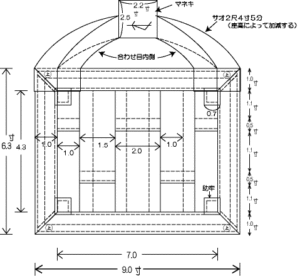
The size of the gojōe varies in size: measurements given in kane-jaku; width – 1.5, 1.7, 1.75, and 1.9 shaku.
The pattern of the silk kobukusa is called En-shū Ichi-matsu takara, 遠州市松宝, Distant-state City-pine-treasure, which is a don-su, 緞子, damask-of. Ichimatsu is named for Sa-no-kawa Ichi-matsu, 佐野川市松, Help-field-river City-pine, a Kabuki actor known for his checkerboard-square patterned hakama, 袴, trousers-horse.
The kobukusa may be, like the kesa, made up of patchwork of different fine fabrics, yose-gire, 寄せ切れ, gather-cut. The kobukusa is folded in half and kept in the kimono near the belly, futokoro, 懐, and is therefore identified as a kai-chū, 懐中古帛紗, belly-middle old-cloth gauze.
It is said that the strips and panels of the kesa were to resemble the flooded rice paddies and their earthen walls. The nine panels are composed of 27 patches. In Buddhist philosophy, the number 27 is the highest level of spiritual attainment in Rupa-loka (the material world). Above that are four more levels of attainment in the non-material world — infinite space, infinite consciousness, nothingness, and finally: neither perception nor non-perception. There are 27 prayer beads in a typical Buddhist mala, or rosary (108 ÷ 4). The number 108 refers to undesirable human afflictions that prevent enlightenment, and must be dispelled. The New Year is greeted with the ringing of temple bells 108 times. The number can also be seen as a combination of 10 and 8, which are both auspicious.
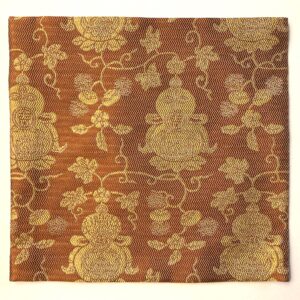
The hyō-tan, 瓢箪, gourd-basket, is highly revered in Buddhism, Shintō, and is a sacred symbol in Taoism. The Kanji depicted in the gourd is yoshi, 吉, good luck, which is a source for the name of the fabric design.
For further study, see also: Furo and the Maekawarake, Furo: Four Sacred Mountains, and Kobukusa

